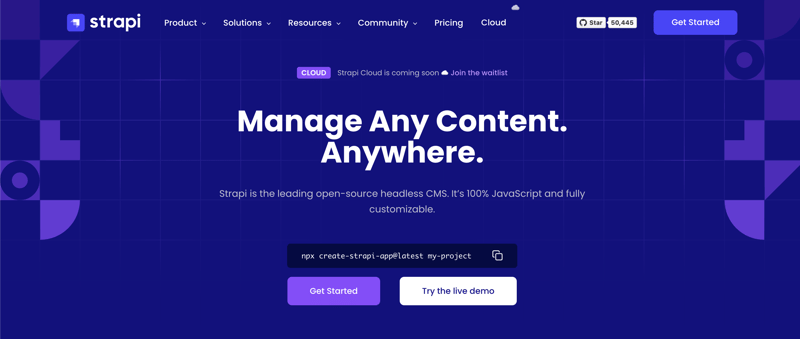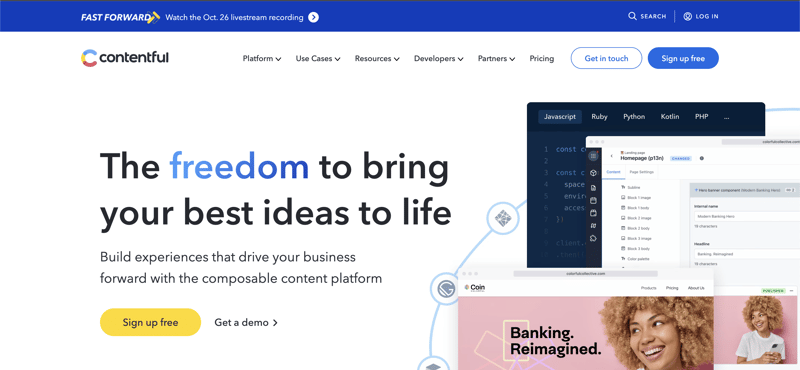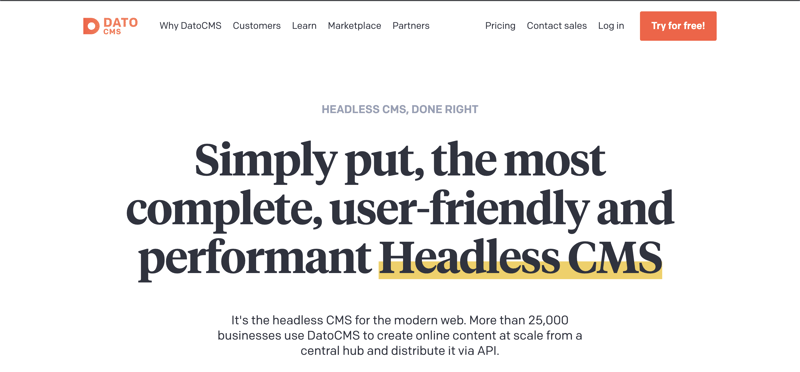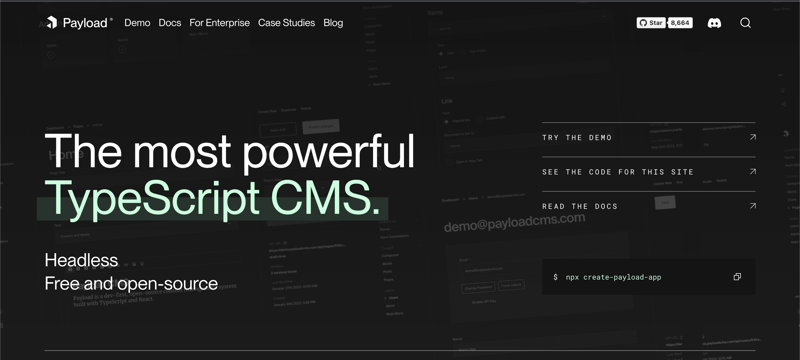A headless ecommerce CMS (content management system) allows developers enough flexibility to create and manage content for their online stores without the need for a traditional, monolithic CMS.
In a headless CMS, the frontend and the backend are decoupled, meaning that the frontend (the user interface) and the backend (the content management and storage) are managed and developed independently.
This allows developers to use any technology they want for the frontend, such as React, Angular, or Vue.js, and to create a flexible and scalable ecommerce website.
This article explains the benefits of using headless CMS, lists some of the top headless CMS platforms, and explores combining headless CMS with ecommerce platforms.
What is Medusa? Medusa is a composable commerce engine that facilitates for developers to build ecommerce systems as components. Medusa provides a plugin system that allows developers to integrate third-party CMS services like the ones mentioned in this article within their ecommerce ecosystem.
Benefits of Headless CMS
A headless CMS is a type of CMS that separates the backend system that stores and manages the content from the frontend system that presents the content to the user.
Suggested Read: Headless Architecture Explained to a 5-Year-Old
In this architecture, the CMS functions as a content repository that can deliver content through APIs (application programming interfaces) to any number of frontend systems, such as web or mobile applications, smart speakers, or IoT (Internet of Things) devices.
Some benefits of using a headless CMS include:
- Flexibility: Because a headless CMS does not have a frontend user interface, it allows for greater flexibility in terms of how the content can be displayed. This means that the same content can be used on multiple platforms or devices, such as web applications, mobile apps, and digital signage.
- Separation of Concerns: with a decoupled CMS, the content management and display functions are separated, allowing for more flexibility and ease of development.
- Performance: the content is generally delivered to the client through an API, which is faster and more efficient than rendering the content directly on the server.
- Scalability: the headless CMS system can be designed and optimized for specific tasks, such as content management, and can be scaled independently of the frontend display.
1. Strapi
Strapi is an open source, headless CMS designed to build and manage online stores. It is built on Node.js and offers a flexible and scalable way to create and manage content for Ecommerce websites.
With Strapi, developers can create custom content types and manage the data for their online stores using a powerful, user-friendly interface.
Suggested Read: Create an Ecommerce Storefront with Medusa, Strapi, and Remix
Strapi also includes features such as a robust plugin system, built-in security and user management, and integration with popular ecommerce platforms such as Shopify and Medusa.
It is a popular choice among developers looking for a headless CMS for their ecommerce projects.
Features
- Flexible Content Types: Strapi allows you to create and manage custom content types, including rich text, media, and other types of data.
- GraphQL and REST APIs: Strapi provides both GraphQL and REST APIs for accessing and manipulating content, allowing you to deliver content to any platform or device that can consume these APIs.
- User Management and Permissions: Strapi includes built-in user management and permissions, allowing you to control who can access and modify your content. This can be useful for building applications with multiple user roles or for implementing access control rules for specific content.
Check out Strapi’s documentation to learn more about its features.
2. Contentful
Contentful is a headless CMS that can be used for ecommerce websites. It allows developers to create, manage, and distribute content for their online stores using a flexible and scalable content model.
With Contentful, developers can create and manage their content using an intuitive web-based interface, and access that content using a powerful API. This allows them to create rich and engaging user experiences for their eCommerce websites, without being limited by the constraints of a traditional, monolithic CMS.
Suggested Read: How to Connect Medusa and Contentful
Contentful is a popular choice for headless ecommerce CMS because it is flexible, scalable, and easy to use. It also integrates seamlessly with a wide range of ecommerce platforms and tools, making it a versatile solution for building and managing online stores.
Features
- Flexible Content Modeling: Contentful allows you to create custom content types and manage their fields and relationships, allowing you to structure your content in a way that fits your needs.
- Multi-language Support: Contentful provides built-in support for multiple languages, allowing you to manage and deliver content in multiple languages from a single platform.
- Rich Media Support: Contentful provides support for a wide range of rich media types, including images, videos, audio, and other types of assets. This can be useful for creating engaging and immersive content experiences.
Learn more about Contentful and its features in its documentation.
3. Sanity
Sanity is a headless CMS that can be used to build and manage ecommerce websites. It is a flexible and scalable platform that allows developers to create custom content structures and manage their online stores without the constraints of a traditional, monolithic CMS.
With Sanity, developers can use any technology they want for the frontend, such as React, Angular, or Vue.js. They can easily integrate their ecommerce website with other tools and services, such as payment gateways and inventory management systems.
Sanity also provides real-time collaboration features, so multiple team members can work on the website at the same time.
Features
- Custom Schema Builder: Sanity allows you to design and customize the structure of your content by creating custom content types and defining their fields and relationships. This enables you to organize and manage your content in a way that meets your specific requirements.
- Real-time collaboration: Sanity includes built-in collaboration tools, allowing multiple users to work on the same content in real time. This can be useful for teams working on content-driven projects.
- Flexible APIs: Sanity provides flexible APIs for accessing and manipulating content, allowing you to deliver content to any platform or device that can consume these APIs. This can be useful for building content-driven applications that need to support a wide range of use cases.
Learn more about Sanity and its features in its documentation.
4. DatoCMS
DatoCMS is a headless content management system (CMS) that allows developers to create and manage content for their websites and applications. It is a popular choice for ecommerce websites because it provides a flexible and scalable way to build and manage online stores.
With DatoCMS, developers can create and manage the content for their ecommerce websites without the need for a traditional, monolithic CMS.
DatoCMS also provides a number of features and tools that are useful for ecommerce websites. This includes support for multiple languages, customizable content models, and integrations with popular ecommerce platforms like Medusa.
Features
- Customizable Content Modelling: DatoCMS allows you to create custom content types and manage their fields and relationships, allowing you to structure your content in a way that fits your needs.
- Multi-language Support: DatoCMS supports multiple languages, allowing you to manage and deliver content in multiple languages via a single platform.
- Collaboration and Permissions: DatoCMS includes collaboration tools and user permissions, allowing teams to work together on content and control who can access and modify content.
Check out DatoCMS’s documentation to learn more.
5. Payload CMS
Payload CMS is an open source headless CMS and application framework. It provides tools and features for managing and accessing content through APIs, such as a Mongo database, REST and GraphQL APIs, authentication, access control, file storage, and an admin UI.
Headless CMS systems like Payload offer benefits like flexibility, separation of concerns, performance, and scalability. You can use Payload to develop and manage web applications, mobile apps, and other types of content-based applications.
Features
- Mongo Database: Payload CMS uses a Mongo database to store and manage content, allowing for flexible and scalable data management.
- REST and GraphQL APIs: Payload CMS provides both REST and GraphQL APIs for accessing and managing content. It enables you to deliver content to various platforms that are compatible with these APIs.
- User Management and Access Control: Payload CMS provides inbuilt user management and access control; with these, you can decide who has access to your platform. It is useful for building applications with multiple user roles or for implementing access control rules for specific content.
Check out Payload’s documentation to learn more about it.
Combining Headless CMS with Headless Commerce
Headless CMS and headless commerce are both approaches to managing and delivering content and ecommerce functionality, respectively, through APIs instead of traditional user interfaces.
Combining a headless CMS platform with a headless commerce platform like Medusa leads to many benefits including:
- Rich Content Management: Although Medusa provides basic CMS needs, using a dedicated headless CMS platform with Medusa provides more advanced CMS functionalities and capabilities such as localization and versioning.
- Different Interfaces for different teams: Teams that manage the content of the store can use the headless CMS’s dashboard, whereas ecommerce teams can focus on using the Medusa admin.
- Better SEO: CMS platforms allow you to customize information that improves your ecommerce storefront’s SEO, including customizing the URL structure or a product’s meta data.
Medusa has two plugins that you can use to integrate headless platforms:
- An official Contentful Plugin.
- A community Strapi Plugin.
Conclusion
A headless CMS is a content management system that allows you to manage and organize the content of your website without being tied to a specific frontend design. This allows for greater flexibility in the design and functionality of your website.
When combined with composable or headless ecommerce platforms like Medusa, you’ll get many benefits related to flexibility, rich content management which improves your SEO, and more.
Should you have any issues or questions related to Medusa, then feel free to reach out to the Medusa team via Discord.
























